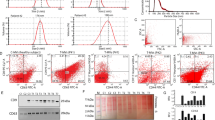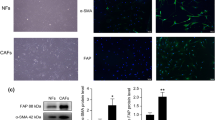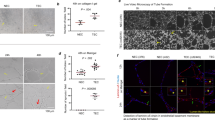Abstract
Malignant mesothelioma is an aggressive tumor arising from the mesothelial cells of serous membranes and is associated with tumor angiogenesis, which is a prerequisite for tumor progression. Vascular endothelial growth factors (VEGFs) including VEGF-A have a crucial role in tumor angiogenesis. However, bevacizumab, a monoclonal antibody to VEGF-A, has recently been reported not to improve the progression-free survival of patients with malignant mesothelioma. Cell culture supernatant contains extracellular components such as serum, which can mask the existence of unknown cell-derived factors in the supernatant and make it difficult to detect the factors by subsequent protein analysis. We tried using serum-free culture for human mesothelioma cell lines, NCI-H28, NCI-H2452 and NCI-H2052, and only NCI-H2052 cells adapted to serum-free culture. We found that serum-free culture supernatant derived from NCI-H2052 cells induces the formation of capillary-like tube structures (tube formation) in three-dimensional culture, in which endothelial cells sandwiched between two layers of collagen or embedded in collagen are incubated with various angiogenic inducers. However, neither neutralization of VEGF-A nor RNA interference of VEGF receptor 2 (VEGFR2) suppressed the supernatant-induced tube formation. Using mass spectrometry, we identified a total of 399 proteins in the supernatant, among which interleukin-8 (IL-8), growth-regulated α-protein, midkine, IL-18, IL-6, hepatoma-derived growth factor, clusterin and granulin (GRN), also known as progranulin (PGRN), were included as a candidate protein inducing angiogenesis. Neutralizing assays and RNA interference showed that PGRN, but not the above seven candidate proteins, caused the supernatant-induced tube formation. We also found that NCI-H28 and NCI-H2452 cells express PGRN. Furthermore, we demonstrate that not only PGRN but also GRN-like protein have an important role in the supernatant-induced tube formation. Thus, mesothelioma-derived GRNs induce VEGF-independent angiogenesis.
This is a preview of subscription content, access via your institution
Access options
Subscribe to this journal
Receive 50 print issues and online access
$259.00 per year
only $5.18 per issue
Buy this article
- Purchase on Springer Link
- Instant access to full article PDF
Prices may be subject to local taxes which are calculated during checkout




Similar content being viewed by others
Accession codes
References
Robinson BW, Musk AW, Lake RA . Malignant mesothelioma. Lancet 2005; 366: 397–408.
Tsao AS, Wistuba I, Roth JA, Kindler HL . Malignant pleural mesothelioma. J Clin Oncol 2009; 27: 2081–2090.
Vogelzang NJ . Chemotherapy for malignant pleural mesothelioma. Lancet 2008; 371: 1640–1642.
Goudar RK . New therapeutic options for mesothelioma. Curr Oncol Rep 2005; 7: 260–265.
Vogelzang NJ, Rusthoven JJ, Symanowski J, Denham C, Kaukel E, Ruffie P et al. Phase III study of pemetrexed in combination with cisplatin versus cisplatin alone in patients with malignant pleural mesothelioma. J Clin Oncol 2003; 21: 2636–2644.
Edwards JG, Cox G, Andi A, Jones JL, Walker RA, Waller DA et al. Angiogenesis is an independent prognostic factor in malignant mesothelioma. Br J Cancer 2001; 85: 863–868.
Kumar-Singh S, Vermeulen PB, Weyler J, Segers K, Weyn B, Van Daele A et al. Evaluation of tumour angiogenesis as a prognostic marker in malignant mesothelioma. J Pathol 1997; 182: 211–216.
Ohta Y, Shridhar V, Bright RK, Kalemkerian GP, Du W, Carbone M et al. VEGF and VEGF type C play an important role in angiogenesis and lymphangiogenesis in human malignant mesothelioma tumours. Br J Cancer 1999; 81: 54–61.
Hanahan D, Folkman J . Patterns and emerging mechanisms of the angiogenic switch during tumorigenesis. Cell 1996; 86: 353–364.
Ebos JM, Kerbel RS . Antiangiogenic therapy: impact on invasion, disease progression, and metastasis. Nat Rev Clin Oncol 2011; 8: 210–221.
Dvorak HF . Vascular permeability factor/vascular endothelial growth factor: a critical cytokine in tumor angiogenesis and a potential target for diagnosis and therapy. J Clin Oncol 2002; 20: 4368–4380.
Welti J, Loges S, Dimmeler S, Carmeliet P . Recent molecular discoveries in angiogenesis and antiangiogenic therapies in cancer. J Clin Invest 2013; 123: 3190–3200.
Dowell JE, Dunphy FR, Taub RN, Gerber DE, Ngov L, Yan J et al. A multicenter phase II study of cisplatin, pemetrexed, and bevacizumab in patients with advanced malignant mesothelioma. Lung Cancer (Amsterdam, Netherlands) 2012; 77: 567–571.
Eguchi R, Fujimori Y, Ohta T, Kunimasa K, Nakano T . Calpain is involved in cisplatin-induced endothelial injury in an in vitro three-dimensional blood vessel model. Int J Oncol 2010; 37: 1289–1296.
Kerbel RS . Tumor angiogenesis. N Engl J Med 2008; 358: 2039–2049.
Keeley EC, Mehrad B, Strieter RM . CXC chemokines in cancer angiogenesis and metastases. Adv Cancer Res 2010; 106: 91–111.
Kadomatsu K, Bencsik P, Gorbe A, Csonka C, Sakamoto K, Kishida S et al. Therapeutic potential of midkine in cardiovascular disease. Br J Pharmacol 2014; 171: 936–944.
Palma G, Barbieri A, Bimonte S, Palla M, Zappavigna S, Caraglia M et al. Interleukin 18: friend or foe in cancer. Biochim Biophys Acta 2013; 1836: 296–303.
Guo Y, Xu F, Lu T, Duan Z, Zhang Z . Interleukin-6 signaling pathway in targeted therapy for cancer. Cancer Treat Rev 2012; 38: 904–910.
Bao C, Wang J, Ma W, Wang X, Cheng Y . HDGF: a novel jack-of-all-trades in cancer. Fut Oncol (London, England) 2014; 10: 2675–2685.
Koltai T . Clusterin: a key player in cancer chemoresistance and its inhibition. OncoTargets Ther 2014; 7: 447–456.
He Z, Bateman A . Progranulin (granulin-epithelin precursor, PC-cell-derived growth factor, acrogranin) mediates tissue repair and tumorigenesis. J Mol Med (Berlin, Germany) 2003; 81: 600–612.
Bhandari V, Bateman A . Structure and chromosomal location of the human granulin gene. Biochem Biophys Res Commun 1992; 188: 57–63.
Zhou J, Gao G, Crabb JW, Serrero G . Purification of an autocrine growth factor homologous with mouse epithelin precursor from a highly tumorigenic cell line. J Biol Chem 1993; 268: 10863–10869.
He Z, Ong CH, Halper J, Bateman A . Progranulin is a mediator of the wound response. Nat Med 2003; 9: 225–229.
Ho JC, Ip YC, Cheung ST, Lee YT, Chan KF, Wong SY et al. Granulin-epithelin precursor as a therapeutic target for hepatocellular carcinoma. Hepatology (Baltimore, MD) 2008; 47: 1524–1532.
Pan CX, Kinch MS, Kiener PA, Langermann S, Serrero G, Sun L et al. PC cell-derived growth factor expression in prostatic intraepithelial neoplasia and prostatic adenocarcinoma. Clin Cancer Res 2004; 10: 1333–1337.
Yang D, Wang LL, Dong TT, Shen YH, Guo XS, Liu CY et al. Progranulin promotes colorectal cancer proliferation and angiogenesis through TNFR2/Akt and ERK signaling pathways. Am J Cancer Res 2015; 5: 3085–3097.
Davidson B, Alejandro E, Florenes VA, Goderstad JM, Risberg B, Kristensen GB et al. Granulin-epithelin precursor is a novel prognostic marker in epithelial ovarian carcinoma. Cancer 2004; 100: 2139–2147.
Sun X, Gulyas M, Hjerpe A . Mesothelial differentiation as reflected by differential gene expression. Am J Resp Cell Mol Biol 2004; 30: 510–518.
Toh H, Cao M, Daniels E, Bateman A . Expression of the growth factor progranulin in endothelial cells influences growth and development of blood vessels: a novel mouse model. PLoS One 2013; 8: e64989.
Cenik B, Sephton CF, Kutluk Cenik B, Herz J, Yu G . Progranulin: a proteolytically processed protein at the crossroads of inflammation and neurodegeneration. J Biol Chem 2012; 287: 32298–32306.
Gijselinck I, Van Broeckhoven C, Cruts M . Granulin mutations associated with frontotemporal lobar degeneration and related disorders: an update. Hum Mutat 2008; 29: 1373–1386.
Karch CM, Jeng AT, Skorupa T, Cruchaga C, Goate AM . Novel progranulin variants do not disrupt progranulin secretion and cleavage. Neurobiol Aging 2013; 34: 2538–2540.
Eguchi R, Naitou H, Kunimasa K, Ayuzawa R, Fujimori Y, Ohashi N et al. Proteomic analysis of hypoxia-induced tube breakdown of an in vitro capillary model composed of HUVECs: potential role of p38-regulated reduction of HSP27. Proteomics 2008; 8: 2897–2906.
Eguchi R, Kubo S, Ohta T, Kunimasa K, Okada M, Tamaki H et al. FK506 induces endothelial dysfunction through attenuation of Akt and ERK1/2 independently of calcineurin inhibition and the caspase pathway. Cell Signal 2013; 25: 1731–1738.
Gourlaouen M, Welti JC, Vasudev NS, Reynolds AR . Essential role for endocytosis in the growth factor-stimulated activation of ERK1/2 in endothelial cells. J Biol Chem 2013; 288: 7467–7480.
Eguchi R, Kubo S, Takeda H, Ohta T, Tabata C, Ogawa H et al. Deficiency of Fyn protein is prerequisite for apoptosis induced by Src family kinase inhibitors in human mesothelioma cells. Carcinogenesis 2012; 33: 969–975.
Acknowledgements
We are grateful to Ms Naoko Hamaue and Mr Daiki Haruguchi for their excellent technical assistance. This work was supported by a Grant-in-Aid for Researchers, Hyogo College of Medicine, 2013, the MEXT-Supported Program for the Strategic Research Foundation at Private Universities, 2012–2015 and JSPS KAKENHI Grant Number 16K14626.
Author information
Authors and Affiliations
Corresponding author
Ethics declarations
Competing interests
The authors declare no conflict of interest.
Additional information
Supplementary Information accompanies this paper on the Oncogene website
Supplementary information
Rights and permissions
About this article
Cite this article
Eguchi, R., Nakano, T. & Wakabayashi, I. Progranulin and granulin-like protein as novel VEGF-independent angiogenic factors derived from human mesothelioma cells. Oncogene 36, 714–722 (2017). https://doi.org/10.1038/onc.2016.226
Received:
Revised:
Accepted:
Published:
Issue Date:
DOI: https://doi.org/10.1038/onc.2016.226
This article is cited by
-
PGRN inhibits CD8+T cell recruitment and promotes breast cancer progression by up-regulating ICAM-1 on TAM
Cancer Immunology, Immunotherapy (2024)
-
Complexity of progranulin mechanisms of action in mesothelioma
Journal of Experimental & Clinical Cancer Research (2022)
-
Neurovascular dysfunction in GRN-associated frontotemporal dementia identified by single-nucleus RNA sequencing of human cerebral cortex
Nature Neuroscience (2022)
-
Progranulin deficiency in Iba-1+ myeloid cells exacerbates choroidal neovascularization by perturbation of lysosomal function and abnormal inflammation
Journal of Neuroinflammation (2021)
-
Expression of ID4 protein in breast cancer cells induces reprogramming of tumour-associated macrophages
Breast Cancer Research (2018)



